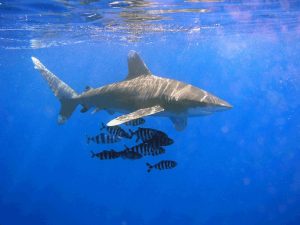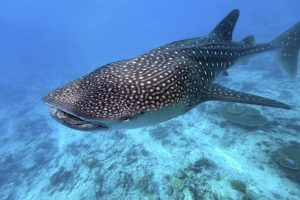Freediving with Sharks
Instructor course handout
Khaled ELGammal
Introduction
-
What do we know about Sharks?
-
How to react in an encounter?
-
Do all Sharks behave the same?
-
What attracts Sharks?
-
Is it Safe to Freedive around Sharks?

Sharks Misconceptions
All Sharks are Dangerous
Not all sharks are large, bulky and scary-shaped like the ones we see in movies. There are actually more than 400 different species of sharks and they come in a variety of shapes and sizes, from as short as 8-inch-long all the way to the massive 40-foot-long. Some sharks has tiny teeth that it doesn’t even use for feeding, others has molar-like teeth that it uses to crush hard-shelled prey & some others don’t even have teeth at all!
Sharks are Eating Machines
There are thousands of encounters between humans and sharks every day that do not end in swimmers, surfers and divers being attacked, bit, or eaten. This alone is a proof to classify this statement as false.
Humans are not food for sharks. The sharks involved in incidents with humans are often hunting for similar-sized prey to humans, such as seals. The majority of shark species actually eat fish or invertebrates, such as squid or clams.
Some types of sharks are curious by nature, they can come close to humans like as close as bumping into humans, they are only trying to figure out what really are we, on the other hands a lot of other types of sharks are considered to be very shy, once they see any unfamiliar object that moves in the water around them, they just swim away the other direction.
Shark Attacks are Fatal
As just explained in the previous point, shark attacks on humans are usually by mistake, so as they do bite, they realize they are not really interested, and they don’t come for more, fatality when it happens, the main reason behind it is the bleeding wasn’t controlled in a timely manner, not that they were eaten.
It Happens All the Time!
Well, a lot of researches been made on the likelihood of humans to be attacked by sharks are very low, comparing it with a very rare events such as:
Humans dying from Fireworks: we are more than 10 times likelier to die from fireworks than dying from a shark attack.
Humans dying from Lightening strike: we are around 50 times likelier to die from a lightning strike than dying from a shark attack.
Sharks Have Poor Eye Sight
It was once thought that sharks had poor eyesight. It is known now that sharks have very good eyesight.
Vision abilities vary among the different shark species and depend on the size, focusing ability and strength of the eyes. A shark’s eye includes a cornea, iris, lens and retina just like ours, and has rods and cones, allowing the shark to see in color and at different levels of light. Most shark’s see their prey when it is about 20 to 40 meters away. To protect their eyes from thrashing prey, some sharks, like the tiger shark, cover their eyes with a nictitating membrane, while others, like the great white shark, roll their eyes back into the sockets.
Sharks Have to Keep Swimming to Breathe
Sharks needs to have water flow through their gills to be able to get the oxygen filtered, however, some sharks managed to face underwater currents and stay still, allowing water to keep flowing into their gills, Some other sharks, particularly those that are not active swimmers, breathe using buccal pumping. This method gets its name from the buccal (mouth) muscles that actively draw water into the mouth and over the gills, allowing the sharks to respire while remaining still.
When Dolphins are Around, Sharks Won’t
This misconception is often associated with a shark safety tip: “If you see dolphins, it’s safe to swim there because their presence scares away sharks.” This is simply not correct. In fact, sharks and dolphins are often found near each other for a simple reason—they eat the same food, and both go where the food is, however, Dolphins fight sharks sometimes, and since dolphins usually swim in pods they usually scare away a single shark.
The Real Danger of These Misconceptions!
Is people actually taking actions based on these false misconceptions, starting for wrong reactions when encounters occur, to a false reason for hunting sharks down, and messing around with the eco balance system.
Types of Sharks In Egypt (Areas)
Oceanic White Tip
Oceanic white tip sharks (also known as Longimanous) are considered to be very curious and from the top predators in the ocean food chain, they live in relatively warm water and cold waters, their average length could reach 6-8m long.
Egypt – Marsa Alam, Hamata.

Hammerheads
They usually live in schools, they are recognized by their flat headed shape with both eyes on each end. Mostly found in deep waters and their favorite hunts are the stingrays camouflaged in the sand. Their average length could reach 5-7 meters.
Egypt – Sharm Elsheikh, Elphinstone reef, Daedulus Reef, Hamata.

Tiger Sharks
Known for their “tiger” prints/ patterns on their skin, their average length is around 5meters long, they can visit shallow waters and here comes their risks on attacks on swimmers.
Egypt- St Johns reef – southern parts of Egypt Boarders.

Thresher
Easily recognized by their long Tail, they actually hunt with whiplashing their tail into their bates, their tail can be equal to their actual size.
Egypt- Brother Islands, Daedulus reef, southern part of Egyptian boarder.

Whale Sharks
Largest in size of all types of sharks, lengths could reach 18 meters, average lengths is 5.5 – 10 meters. They are toothless. And they feed on planktons and small fish by filtering water through their mouth.
Egypt – Hurghada, Dahab, Sharm ELsheikh, Marsa Alam, Safaga, Quseir.

Mako
Fastest known sharks, their speed could actually reach 18 meters per second, and they are relatively shorter than other sharks, their average length is around 3.5-5 meters. Also known by the name of shortfin.
Egypt – Ain ELSokhna.

Scenarios
Planned Dives
When you know that you are entering waters with high chance of encountering sharks, so you’re kind of prepared mentally and ready for, we will get in touch later on with the proper planning and considerations you consider before getting into the water.
Non Planned Dives
When you are in the middle of session/water, then you have an unexpected encounter, we will get in the next topic on what are the do(s) and don’t(s) that should be taken into consideration.
Freediver Reaction & Behaviors:
-
Keep your arms close to you, sharks tend to go for loose ends as it’s easier to bite.
-
Stay Calm, so you would be able to think and act, you need to stay calm, sharks as well will sense if you’re a bit tensed and may get aggravated.
-
Don’t do any rapid movement “such as swimming away”, sharks automatically would assume you’re maybe having trouble and will sense you could be in a weak state, and they could mistaken you for a seals or turtles on surface.
-
Heads on a Swivel “always keep an eye”, always look around as sharks would show up in a second and you need to be attentive and keep an eye with the shark at all times as long as they are visible.
-
Reduce your time on Surface, so you won’t trigger a curious shark to come to surface and increase the chance of an attack.
-
Try and be in Vertical position in close encounters, this would magnify your size in the sharks’ eyes, and could scare them away.
-
Evaluate, assess the situation, if you noticed the shark behavior is being aggressive you should end the dive and slowly get out of the water.
Research
-
Part of the Plan for your dives
-
Wear a wetsuit if diving in area with sharks
-
Avoid wearing bright colors equipment
-
Avoid Dusk & Dawn Dives
-
Questions to ask
-
Is there sharks in the area?
-
What types of sharks?
-
Any recent encounters?
-
References
Photo Credits
https://oceana.org/blog/what-are-some-biggest-threats-facing-sharks
https://www.nationalgeographic.com/animals/2019/08/mako-shark-protections-cites/
https://en.wikipedia.org/wiki/Tiger_shark

